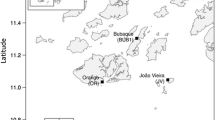Abstract
Shell disturbances and soft tissues butyltin burden were investigated in commercial bivalves Lithophaga lithophaga, Mytilus galloprovincialis, Solen marginatus and Crassostrea gigas from the Bizerta lagoon. Shell disturbances were found in all bivalves, being scarce in S. marginatus. In the internal valve of L. lithophaga, burrowing annelids and sipunculids living inside galleries were observed, while in the external valve, brown-blackish or white stains were found. In M. galloprovincialis, a yellowish mass located at the shell anterior side was found fixed firmly to the pearly layer by a hard brownish structure covering some annelid elliptic eggs. In the internal shell layer of some specimens collected in April, embryos belonging to tubiculous annelids at various developmental stages were observed. In C. gigas, shell thickening was revealed in some specimens corresponding to white doughy deposits at the internal valve and between shell layers. In S. marginatus, only one specimen showing a cavity at the posterior site was found. Total butyltin concentrations in the studied bivalves varied between 30 and 245 ng/g dry weight with tributyltin (TBT) being the predominant compound. The highest concentration was recorded in L. lithophaga collected from the Bizerta Bay and the lowest concentration in S. marginatus from Maghraoua. This study provided baseline data that could serve for long-term monitoring of TBT pollution in Tunisia, since legislation to reduce the use of TBT-based antifouling paints has not been introduced yet.




Similar content being viewed by others
References
Alzieu, C., Héral, M., Thibaud, Y., Dardignac, M. J., & Feuillet, M. (1981). Influence des peintures antisalissures à base d’organostanniques sur la calcification de la coquille de l’huitre Crassostrea gigas. Revue des Travaux de l’Institut des pêches maritimes, 45, 101–116.
Alzieu, C., Sanjuan, J., Deltriel, J. P., & Borel, M. (1986). Tin contamination in Arcachon bay: Effects on oyster shell anomalies. Marine Pollution Bulletin, 17, 494–498.
Buschbaum, C., & Reise, K. (1999). Effects of barnacle epibionts on the periwinkle Littorina littorea (L.). Helgoland Marine Research, 53, 56–61.
Buschbaum, C., & Saier, B. (2001). Growth of the mussel Mytilus edulis (L.) in the Wadden Sea affected by tidal emergence and barnacle epibionts. Journal of Sea Research, 45, 27–36.
Catherine, M. B., Mazurie, D. J., & Le Bec, C. (1989). Anomalies des coquilles d’huîtres creuses Crassostrea gigas observés sur le littoral français en mai juin 1989 dues au ver Polydora et aux peintures antisalissures. Equinoxe, 31, 24–31.
Coelho, M. R., Langston, W. J., & Bebianno, M. J. (2006). Effect of TBT on Ruditapes decussatus juveniles. Chemosphere, 63, 1499–1505.
Díez, S., Abalos, M., & Bayona, J. M. (2002). Organotin contamination in sediments from the Western Mediterranean enclosures following 10 years of TBT regulation. Water Research, 36, 905–918.
El Bour, M., Attia, H., Paillard, C., Mraouna, R., Ayari, W., & El Abed, A. (2002). Etude de dépistage de la maladie de l’anneau brun et détermination des germes bactériens associés chez la palourde (Tapes decussatus) des côtes tunisiennes. Bulletin National des Sciences et Technique de la Mer, 7, 56–59.
Grassé, P. P. (1959). Traité de Zoologie: Anatomie, Systématique, Biologie (5th ed.). Paris: Masson. 1053.
Jaafar Kefi, F., Trigui El Menif, N., Le Pennec, M., & Boumaiza, M. (2004). Perturbations coquillières chez le mollusque bivalve Lithophaga lithophaga prélevée dans la baie de Bizerte (Tunisie). Bulletin de la Société Zoologique de France, 4, 419–426.
Lahbib, Y., Abidli, S., Chiffoleau, J. F., Averty, B., & Trigui El Menif, N. (2009). First record of butyltin body burden and imposex status in Hexaplex trunculus (L.) along the Tunisian coast. Journal of Environmental Monitoring, 11(6), 1253–1258.
Machado, J., Coimbra, J., & Sá, C. (1989). Shell thickening in Anodonta cygnea by TBTO treatments. Comparative Biochemistry and Physiology C, 92, 77–80.
Menzel, R. W. (1974). Portuguese and Japanese oysters are the same species. Journal of the Fisheries Research Board of Canada, 31, 453–456.
Mzoughi, N., Lespes, G., Bravo, M., Dachraoui, M., & Potin-Gautier, M. (2005). Organotin speciation in Bizerte lagoon (Tunisia). Science of the Total Environment, 349, 211–222.
Nell, J. A., & Chvojka, R. (1992). The effect of bis-tributyltin oxide (TBTO) and copper on the growth of juvenile Sidney rock oysters Saccostrea commercialis and Pacific oyster Crassostrea gigas. Science of the Total Environment, 125, 193–201.
Salazar, M. H., & Salazar, S. M. (1991). Assessing site-specific effects of TBT contamination with mussel growth rates. Marine Environmental Research, 32, 131–150.
Thain, J. E., & Waldock, M. J. (1986). The impact of tributyltin (TBT) antifouling paints on molluscan fisheries. Water Science and Technology, 18, 193–202.
Tinoco-Orta, G. D., & Caceres Martinez, J. (2003). Infestation of the clam Chione fluctifraga by the burrowing worm Polydora sp. nov. in laboratory conditions. Journal of Invertebrate Pathology, 83, 196–205.
Trigui El Menif, N., Guezzi, Y., Le Pennec, M., Boumaiza, M., & Le Pennec, G. (2005). Infestation of the clam Venus verrucosa by sipunculoidea and the lithophagous bivalve Gastrochaena dubia. Acta Adriatica, 46, 83–90.
Trigui El Menif, N., Jaafar Kefi, F., Ramdani, M., Flower, R., & Boumaiza, M. (2007). Habitat and associated fauna of Lithophaga lithophaga (Linné 1758) in the bay of Bizerta (Tunisia). Journal of Shellfish Research, 26, 569–574.
Trigui El Menif, N., Guezzi, Y., Lahbib, Y., Ramdani, M., & Roger, F. (2008). Effects of biogenic concretions, epibionts and endobionts on the relative growth of the clam Venus verrucosa in Bizerta lagoon, Tunisia. Journal of Shellfish Research, 27, 1–6.
Wahl, M. (1996). Fouled snails in flow: potential of epibionts on Littorina littorea to increase drag and reduce snail growth rates. Marine Ecology Progress Series, 138, 157–168.
Witman, J. D., & Suchanek, T. H. (1984). Mussels in flow: drag and dislodgement by epizoans. Marine Ecology Progress Series, 16, 259–268.
Author information
Authors and Affiliations
Corresponding author
Rights and permissions
About this article
Cite this article
Kefi, F.J., Lahbib, Y., Abdallah, L.G.B. et al. Shell disturbances and butyltins burden in commercial bivalves collected from the Bizerta lagoon (northern Tunisia). Environ Monit Assess 184, 6869–6876 (2012). https://doi.org/10.1007/s10661-011-2464-1
Received:
Accepted:
Published:
Issue Date:
DOI: https://doi.org/10.1007/s10661-011-2464-1




